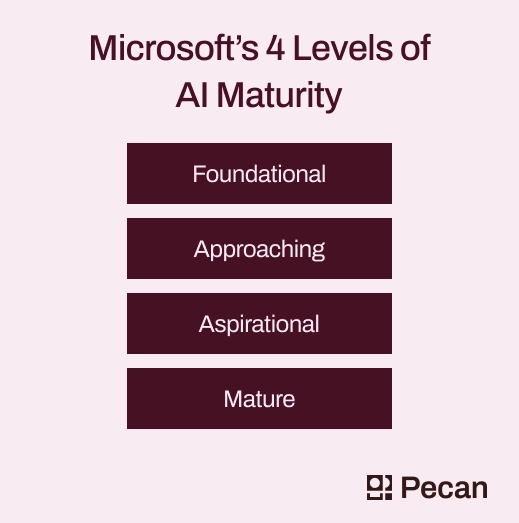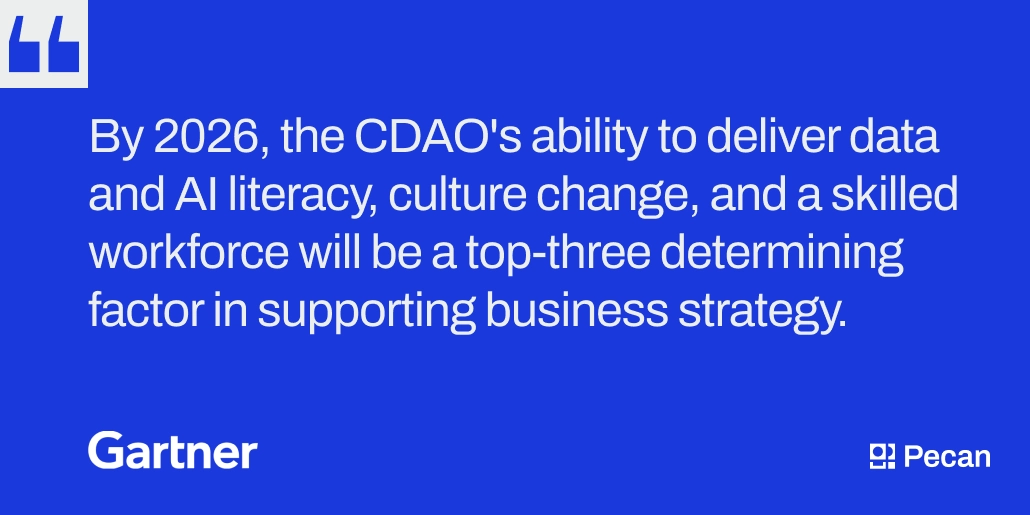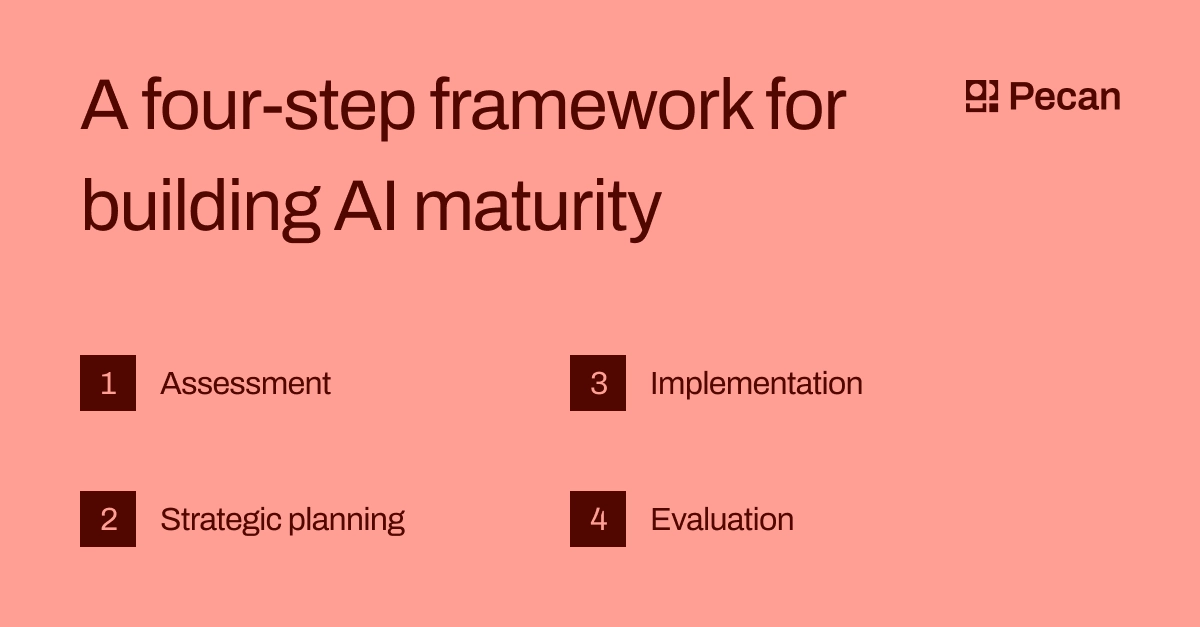In a nutshell:
- AI maturity is the level of preparedness an organization has for implementing AI, with four tiers: foundational, approaching, aspirational, and mature.
- Assessing AI maturity involves evaluating openness, technical infrastructure, talent, and governance within the organization.
- Accelerating AI maturity involves consistent assessment, investment in improving key areas, and strategic planning.
- Pecan's predictive AI platform can help organizations accelerate their AI maturity by simplifying integration, accelerating model production, and optimizing a range of AI processes.
- Consider scheduling a demo with Pecan to see how their tool can quickly increase your organization's AI maturity.
It’s become nearly impossible to get through a work meeting without a mention of artificial intelligence.
While AI is a trending topic — to say the least — we also know it is and will have a direct impact on business growth. Businesses that have the most mature AI implementation are seeing up to a 30% revenue increase that can be directly attributed to AI.
The challenge, however, is getting from point A to point B — from just experimenting with AI to an AI powerhouse.
In this article, we’ll explore the concept of AI maturity. We’ll also discuss how to assess your organization’s maturity and, of course, how to accelerate it.
What is AI maturity?
AI has made a name for itself in professional settings across all industries, but its adoption isn’t uniform. The extent to which an organization can incorporate AI depends on its readiness to embrace the technology, a concept known as AI maturity.
In other words, AI maturity is the level of preparedness your organization has for implementing AI.
While there are different ways to conceptualize your company’s AI maturity, Microsoft has created a simple maturity level scale that identifies four tiers of AI maturity: foundational, approaching, aspirational, and mature.
-

- The levels of AI maturity, based on Microsoft research
Foundational
The foundational level of maturity is an introductory — or even skeptical — usage of AI. According to Gartner’s AI maturity model, these organizations are considered aware but too blocked by obstacles to begin experimenting with AI.
Organizations with foundational AI maturity may not be confident AI is worth the investment. If these companies have left the “awareness” stage and started using AI tools, they don’t know much about them.
Technically, the organization is not incorporating AI to its full advantage, and culturally, the organization isn’t fully ready to embrace it.
In 2023, 65% of companies weren’t using AI at all. It’s likely that many of these companies weren’t technologically or culturally ready for the tool’s impact.
Approaching
The next level is the approaching maturity level. This is an early stage where organizations have started to implement AI and are growing momentum about the tool’s positive impacts.
Companies at this tier of maturity are curious about investing more in AI. They’re looking into custom options for the company and upping their technological capabilities. Approaching-level companies are optimistic about AI implementation and learning more very quickly.
Aspirational
Companies with aspirational-level AI maturity are getting pretty comfortable with AI. Their implementation of AI tools is more complex. Their organization likely has some custom tools, and they’re experimenting with leveling up the types of AI they’re using.
Aspirational organizations have seen a change in their company culture, and AI is becoming a major determinant of business strategy. Teams may be built around certain AI objectives, and more resources are being poured into the tool than at any other level.
Aspirational companies are also getting curious about the ethical implications of AI. They’re considering AI from many angles because they understand the fundamentals.
Mature
Mature-level organizations have the deepest and most complex conception of artificial intelligence. AI is integrated into many aspects of the organization with custom tools and advanced implementation.
Mature organizations may be leaders in artificial intelligence applications, using the tools in creative and novel ways. These companies are trying new things and deeply questioning the ethics of AI. They want to take full advantage of the tool while maintaining data safety and ethical standards.
Accenture calls this final tier of AI users “AI Achievers” and identifies that only 12% of organizations are at this level. However, they also suggest that that number will grow to 27% by the end of 2024.
Bridging AI Maturity Levels with Business Growth
After exploring the different levels of AI maturity, it's crucial to understand how each step forward can translate into tangible business outcomes.
- From foundational to approaching: At this initial leap, businesses often witness an increase in operational efficiency as they start automating routine tasks. This reduces costs and frees up your team's time to focus on more strategic initiatives, laying the groundwork for innovation and growth.
- Approaching to aspirational: This transition marks a period of significant transformation, where AI's role evolves from operational to strategic. Businesses at this stage start to see AI as a driver for new revenue streams, whether through improved customer insights leading to better product offerings or through enhanced service delivery.
- Aspirational to mature: Achieving mature AI integration means AI is no longer just a tool but a core component of your business strategy. At this stage, businesses often experience a marked increase in their competitive advantage, leveraging AI for predictive analytics, personalized customer experiences, and innovative solutions that open up new markets.
How do you assess your organization’s AI maturity?
Understanding your organization’s AI maturity is the first step toward improving it. Assessing your current level involves taking a look at a few different factors, including:
Openness
Cultural openness to artificial intelligence is a great initial indicator of maturity because if most members of your company are hesitant or skeptical, you’re likely at the foundational level of maturity. Companies that are optimistic and open are at least at the approaching tier of maturity, depending on your technical implementation of the technology.
Technical Infrastructure
The next important component in your AI maturity assessment is technical infrastructure.
To take advantage of AI tools, you need a technical infrastructure that is capable of high levels of integration. Assess your networking capacity, computing performance, and storage capacity, among other infrastructural variables, as you consider leveling up your AI maturity.
You may need to invest resources into improving your infrastructure before you can fully take advantage of artificial intelligence at your organization.
Talent
While technical resources are a vital part of AI maturity, don’t overlook human resources.
You will need technical talent available to aid in the selection, implementation, and usage of AI tools. If you intend to build your own tools, you’ll also need advanced technical talent.
But the tech department isn’t the only crew you’ll need to assess. Take a look at your marketing, sales, and finance leaders, as well. Everyone who will be using AI to find insights. What’s their level of understanding regarding how AI can improve processes and conclusions?
Mature companies integrate AI in diverse and creative ways, so talent across the board is educated and interested.
-

- Data leaders must focus on data and AI literacy to help their teams achieve AI maturity.
Governance
Finally, to successfully integrate AI into your organization, you’ll need to ensure your tools are compliant. Many AI tools will use your organization’s data to reach its conclusions. Any time data is used, it needs to be compliant, safe, and monitored.
When you’re considering implementing AI, look at your security infrastructure and evaluate the security and trust credentials of any potential vendor. Does your vendor have the security capabilities necessary to engage AI compliantly? If not, you may have to find another provider.
Assess, then accelerate
Once you know where your organization is across a few different variables, you can start planning to take your company to the next level. Here are a few tips to keep you organized while growing your AI strategy:
- Keep returning to the levels of AI maturity as guideposts. Trying to take your organization from foundational to aspirational in a single month won’t happen. Be consistent and diligent in your approach, aiming to grow to the next level without skipping steps.
- Invest in each variable of your AI assessment. Be willing to take time to improve your culture, AI literacy, technical infrastructure, or whatever else is limiting your AI integration. Notice what variables are weighing your organization down and invest in improving them. For example, AI evolution requires an experimental and optimistic culture, which can take time to develop.
- Continually assess your organization’s AI level. Once you’ve made some improvements in your AI maturity, continue to assess your growth. Check in monthly or quarterly to see which areas have improved and which areas are lagging behind. This will keep your strategy efficient and relevant.
A four-step framework for building AI maturity
-

- Taking action to build AI maturity in your organization includes these steps
Here's a simple, actionable framework to guide you through this process:
- Assessment: Use a comprehensive checklist that covers the variables mentioned earlier: cultural openness, technical infrastructure, talent, and governance. Rate your organization in each area to identify strengths and areas for improvement.
- Strategic Planning: Identify specific, actionable steps to level up in each area based on your assessment. For example, if your technical infrastructure is lacking, your plan might include upgrading your data storage capabilities or investing in cloud computing services.
- Implementation: With a clear plan in place, start implementing the necessary changes and even technologies, keeping an eye on immediate wins and long-term goals. Regularly revisit your strategy to adjust as you progress in your AI maturity.
- Evaluation: Continuously measure the impact of your AI initiatives on business outcomes. Use KPIs such as revenue growth, customer satisfaction, and operational efficiency to track your progress and refine your approach.
How can Pecan help you accelerate your AI maturity?
Increasing AI maturity can be a slow process. Improving maturity requires improving variables in several departments, which takes time, money, and energy.
At Pecan, we understand that your organization wants growth — fast. That’s why we’ve designed Pecan’s predictive AI platform to help you skip the line regarding maturity.
Our tool is low-code, meaning your team members can reap the benefits of incredible AI conclusions without being an expert in AI. We help make it easy to:
Integrate AI within the organization
One major hurdle to quick AI implementation is the technical knowledge that’s often required to take advantage of the tools.
Pecan makes it easy to incorporate AI into all aspects of your organization because the tool requires skills your data analysts already have, like SQL.
We care about the democratization of AI within your organization, so we’ve made the platform easy to conceptualize regardless of your background. Everyone from data analysts to marketers can take advantage of Pecan without a coding background, especially with the help of our Predictive GenAI.
Get models into production faster
Another obstacle to quick AI maturity is the time it takes to implement use-case-specific AI models.
Without a low-code solution, organizations must devote significant resources to building models from scratch. This can take months (or longer) as programmers increase their skills and collaborate with departments to identify problems to solve with the model.
A low-code Predictive GenAI solution makes it simple to get models up and running quickly. Pecan’s predictive AI model starts with a generative AI conversation, and then Pecan creates the predictive model itself in SQL.
That means you can expect a custom model with very little time or coding knowledge, accelerating your organization’s AI integration in no time.
Optimize your range of AI processes
Another key benefit of Pecan’s low-code predictive AI is that you can apply it to many use cases without investing significant time into each department’s AI knowledge.
Pecan is built to benefit all parts of your company. If your marketing department’s AI person can chat, they can create a predictive AI model to aid in their strategy. The same applies to your sales department, financial team, or data crew.
Improve your AI maturity with Pecan
Pecan makes it easier than ever to increase your AI maturity quickly. If your organization wants to reap the benefits of the most accessible predictive AI platform on the market, consider scheduling a demo.
We’ll walk you through the tool and answer any of your questions about Pecan and its implementation. You’ll see just how easy it is to bring predictive AI to your organization in no time.



